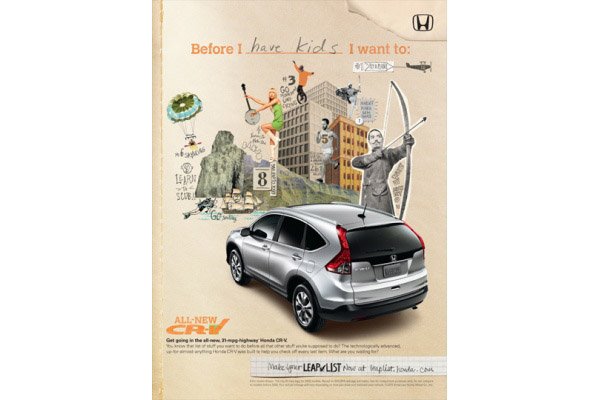

Upon shifting the viewer's attention now to the second advertisement created by Honda, one can grasp almost a similar sense of emotion when compared to advertisement number one. The main difference that has been attached to this particular second advertisement is the phrase at the top, "Before I have kids I want to...." This list along with the first list found in the advertisement can be tied together in that they form an entire campaign as a whole. A campaign which then presumably reflects the life change, the life transition, the change that which the targeted audience, the younger generation will most generally be going through. The idea of this advertisement as well as the first advertisement is that they are trying to imply that with the purchase of this CR-V, it can help you to accomplish things, it is a way for you to actually get these things done. A way for you to actually go about accomplishing the personal ideas that are reflected within your own Leap List. Just as in the first advertisement, the primary focus is directed at the Honda CR-V itself. However, unlike the first advertisement, this second one is only contained on one page, whereas the first one was contained on two pages. Even with the second one, the initial instinct and reaction one may have upon looking at this advertisement may not be instantly lead to the belief that the idea of purchasing this model of car, will then lead to numerous opportunities in regards to one's own personal life. However, after careful review of what is being suggested throughout this page of advertisement, one can grasp a sense of the personalization that it entails, especially with the word I, just as the first one used. I would certainly say that this advertisement is targeted towards the younger generation as that is the age group that typically would be considering the idea of having kids and what their life will be like with kids. Despite the idea that the first advertisement seemed to be directed at the viewing of the younger male audience, as more men tend to fear the day of losing their freedom to marriage, as it is often seen that, "Men are portrayed as having more freedom prior to women entering their lives." (Soman, Dilip; Amar, Cheema) It is the idea that "women should cater to men" (Soman, Dilip; Amar, Cheema) and before them, all the freedom practically in the world is available to men. Just as this first advertisement targets a specific group, this second advertisement seems to target both males as well as females. With this second advertisement, the idea that once a child comes into the picture, the freedom of living life based on what you and your spouse enjoy tends to effect both partners within the relationship and/or marriage. It is the idea that the duty that comes along with a child is not simply just having the capability to care for him/her and raise him/her, but to remove the selfish lifestyle that you have gone about living previous to having kids.
Each of these advertisements contain a particular form of adventure that is to be sought. It is as if the producers are reflecting the idea that this model of car has been specifically designed for those go getters and adventure seekers; those people who are rather not quite ready to sign their personal freedom over to someone or something else, which entails the description contained within the second advertisement of having a child.
Within the second advertisement, there seems to be much minimal wording than when compared to the first. However, there is still such a personal effect that it contains throughout the use of the graphical signs and images contained throughout the entirety of the background of the image. The word I should still be one of the main focuses of what the initial response is to each of these advertisements. It is actually you putting yourself inside of the story that these advertisers/ producers have created. However, the tricky part of this concept with both the first and second advertisement is that the idea that even though despite it may come across as a story that has already been created for your viewing pleasure, what the producers are hoping to imply is that with the CR-V, it is you the viewer who is then entitled to create your own story, which you yourself personally star in. It is the CR-V that has been designed as the primary tool to use to go about creating this story. The advertisers cannot create a Leap List for their viewers, but rather they can provide the information necessary for them to use which will in turn allow them the freedom to create their own.
a class taught by Bob Bednar in the Communication Studies Department at Southwestern University